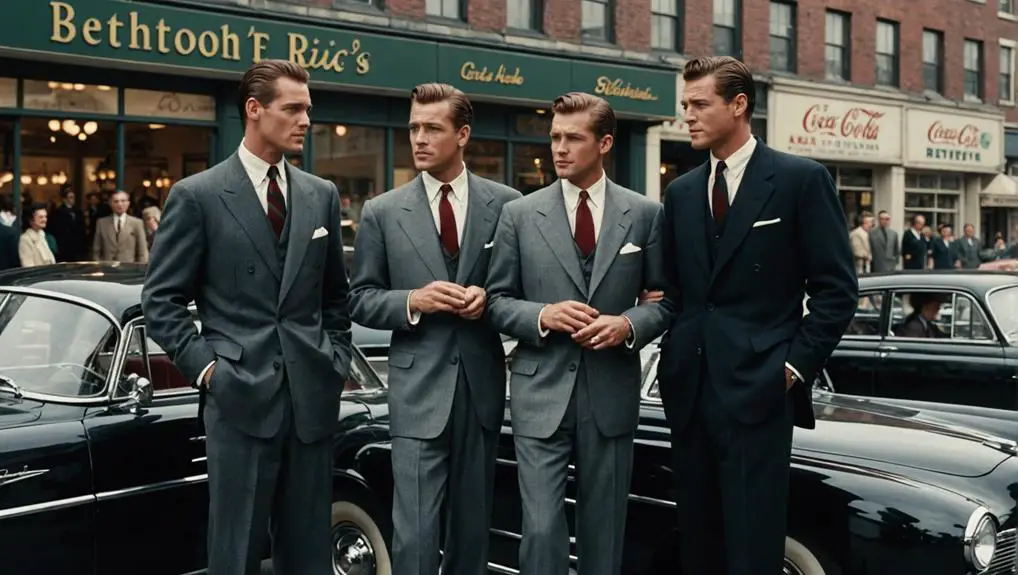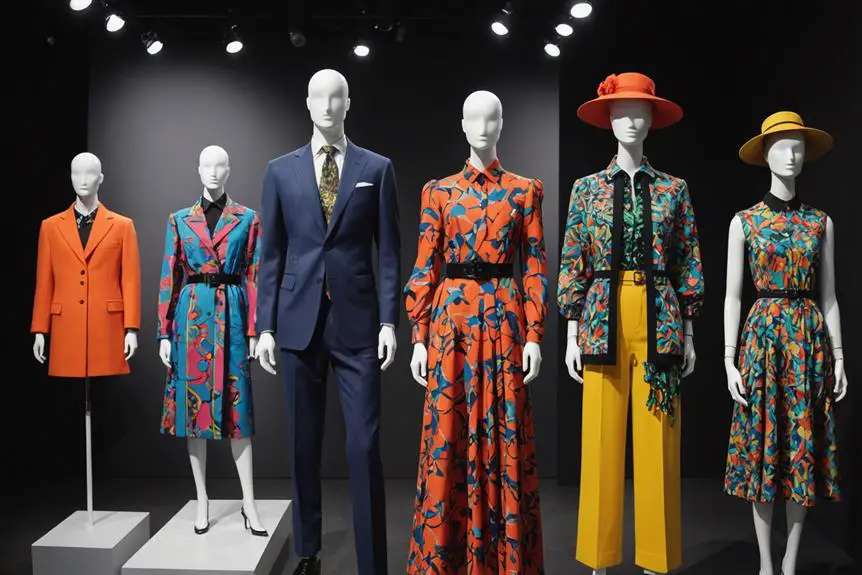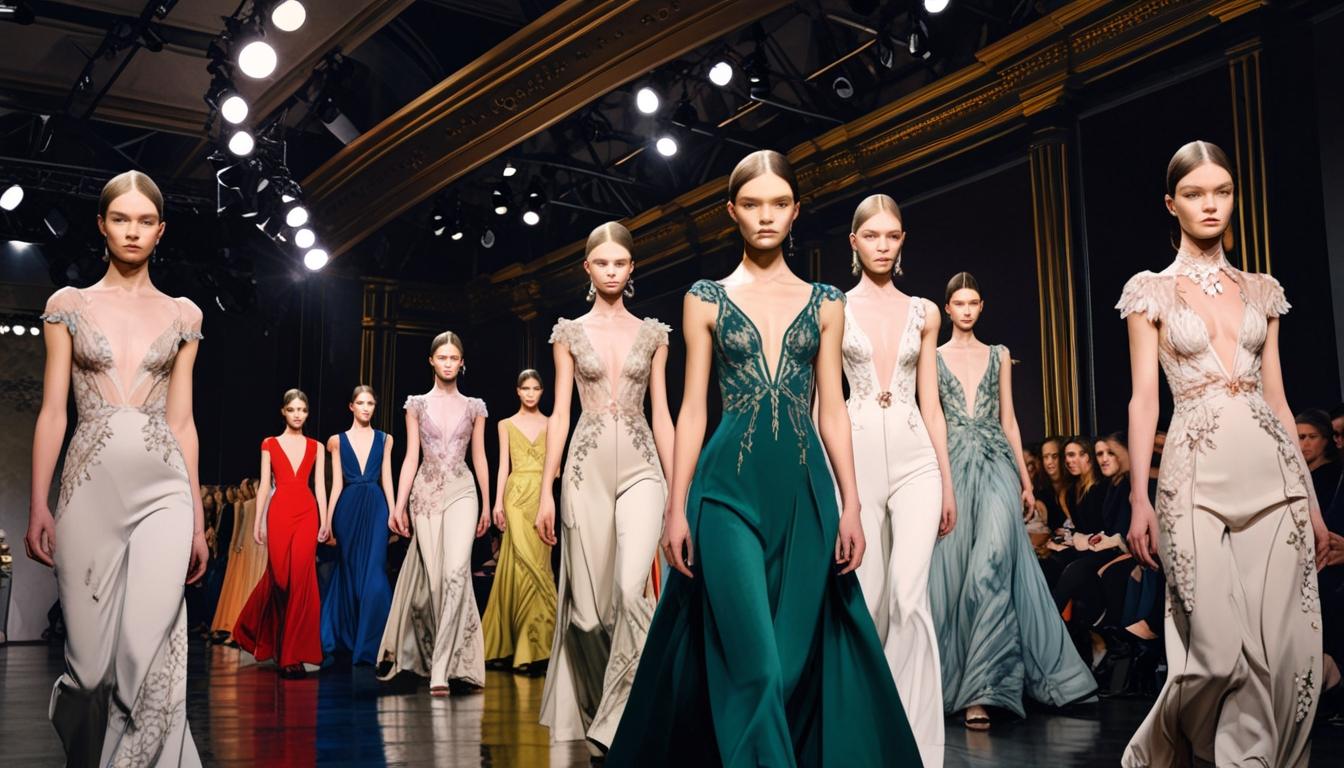In the 1950s, men's scarves transformed into essential fashion accessories that conveyed sophistication and style. This era embraced materials like silk and wool, making scarves both practical and chic. Iconic designs featured bold geometric patterns and vibrant colors, mirroring contemporary artistic movements. Influenced by cultural icons like James Dean, scarves became symbols of masculinity with a flair. They weren't just functional; they added personality to outfits, whether paired with tailored suits or casual wear. This shift in style paved the way for modern accessories. Explore how these choices shaped men's fashion enduringly and discover their lasting impact.
Evolution of Men's Scarves
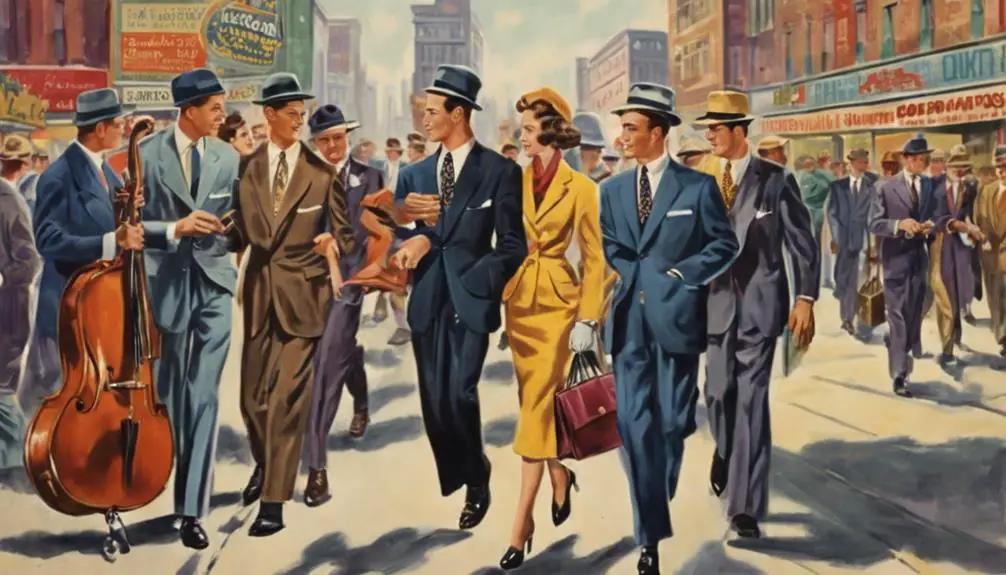
Transforming from mere practical accessories to bold fashion statements, men's scarves in the 1950s underwent a remarkable evolution. This decade marked a significant shift where silk scarves became not just functional items but essential components of a stylish wardrobe. Influenced by Hollywood icons and trendsetters, you could see these accessories gracing both casual and formal attire, reflecting an era that celebrated sophistication.
The introduction of unique prints, particularly geometric and paisley patterns, allowed silk scarves to stand out, serving as eye-catching focal points that complemented outfits. You'd often find these scarves adorned with fringe detailing, enhancing their aesthetic appeal while ensuring comfort when worn loosely around your neck.
Brands like Hermes and Pierre Cardin emerged during this time, elevating the luxurious status of men's scarves and making them highly coveted items among fashionable men. As you navigated through the fashion landscape of the 1950s, it became clear that the silk scarf was more than an accessory; it was a symbol of style evolution that encapsulated the essence of the decade.
Popular Materials Used
What materials defined the elegance of men's scarves in the 1950s? Silk was certainly at the forefront, offering a smooth texture and an elegant sheen that perfectly complemented the fashion trends of the era. This luxurious fabric not only conveyed sophistication but also embraced the artistry of craftsmanship, often featuring hand-rolled edges and intricate designs.
Rayon emerged as another popular choice, celebrated for its versatility and vibrant prints that catered to the bold style preferences of the time. Its lightweight nature made it suitable for both casual and formal occasions, allowing you to express your individuality.
For colder months, wool proved to be a practical option, providing warmth and comfort while maintaining a fashionable appearance. It balanced functionality with style, ensuring that you stayed cozy without sacrificing elegance.
Acetate also gained traction as a more affordable alternative, enabling men to enjoy chic scarf options without the hefty price tag associated with silk. This material opened doors to a wider audience, allowing more men to embrace the scarf trend and elevate their wardrobes with ease. Each fabric choice played a crucial role in defining the stylish landscape of men's scarves during this iconic decade.
Iconic Designs and Patterns
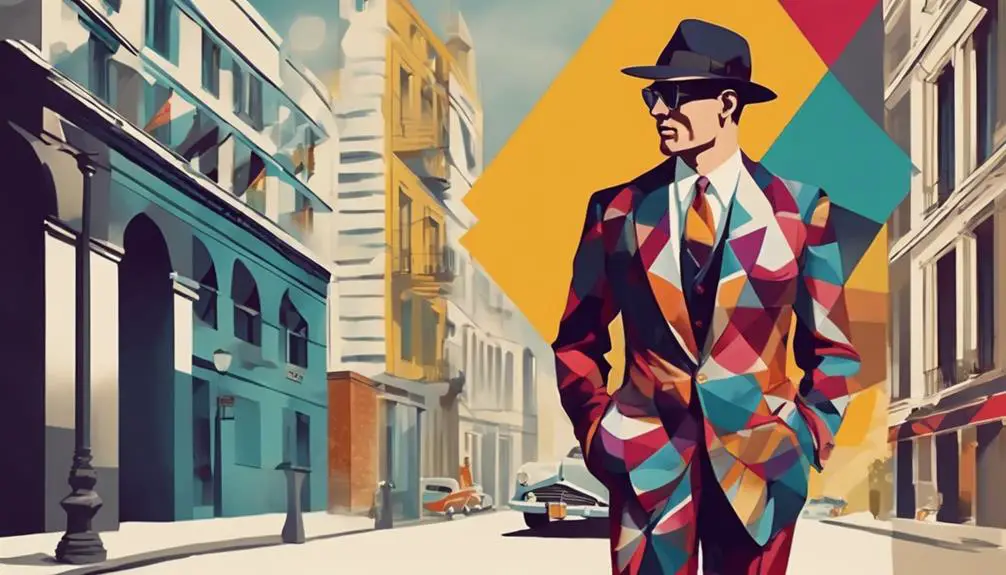
Men's scarves in the 1950s showcased a vibrant array of iconic designs and patterns that captured the spirit of the decade. The scarves weren't just accessories; they were statements of style and modernity. As you explored the fashion of this era, you'd notice several trends that defined these pieces:
- Bold geometric patterns that echoed the modernist movement, often reflecting the unique craftsmanship characteristic of vintage clothing labels.
- Paisley designs, bringing a touch of tradition into contemporary fashion.
- Atomic prints inspired by the fascination with space exploration.
- Vibrant colors, often with abstract motifs, reflecting the art deco influence.
These scarves were crafted from luxurious materials like silk, rayon, and wool, ensuring both elegance and warmth. You'd often see fringed detailing, which added a sophisticated flair to any outfit. Scarves were versatile, seamlessly integrating into both formal and casual looks, allowing men to express their individuality. The mix of patterns and textures not only elevated their outfits but also mirrored the cultural shifts of the time. Essentially, the iconic designs and patterns of men's scarves in the 1950s were a true reflection of the era's bold and innovative spirit.
Scarves as Fashion Statements
During the 1950s, scarves emerged as pivotal fashion statements for men, showcasing not just style but also a sense of identity. These accessories became essential elements in a man's wardrobe, reflecting contemporary trends through bold patterns like paisley and geometric designs. The popularity of vintage labels like Betty Barclay during this era further emphasized the importance of scarves as fashionable add-ons. Crafted from luxurious materials such as silk, rayon, and acetate, scarves emphasized elegance and sophistication. The introduction of unique prints, including atomic motifs, aligned perfectly with the mid-century modern aesthetic, making scarves not just functional, but also a form of self-expression.
You could wear a wool blend scarf to add warmth while still making a statement. The versatility of these scarves allowed you to experiment with various styles, whether opting for a classic knotted look or a more casual draped arrangement. Each choice enhanced your outfit, turning a simple ensemble into a fashion-forward statement. Today, vintage scarves from the 1950s are highly sought after, with collectors willing to pay between $15.00 and $59.00, proving their lasting influence in men's fashion history. By embracing these scarves, you weren't just adopting a trend; you were participating in a cultural moment that celebrated individuality and style.
Practicality and Functionality
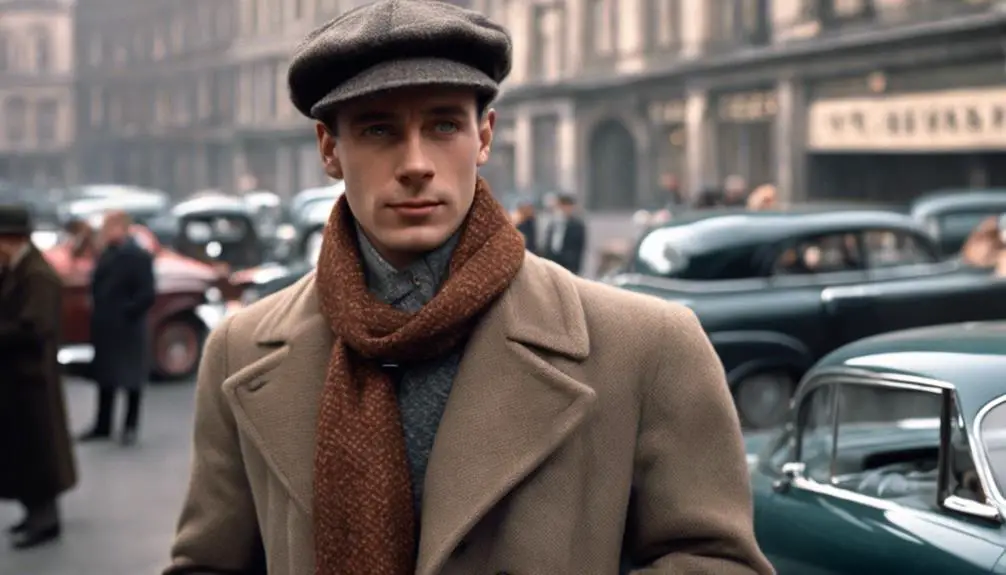
Emphasizing both style and utility, scarves in the 1950s were essential accessories that addressed the practical needs of men's fashion. Made from materials like wool, these scarves not only provided warmth but also enhanced the overall look of any outfit. Vintage clothing labels from this era often indicated the quality and brand of the scarf, which can greatly impact its collectibility today. vintage tag identification can help enthusiasts trace the origins of these unique pieces.
- They protected your neck from cold winds.
- Scarves added an extra layer of insulation under jackets and coats.
- Vibrant patterns, such as paisley and geometric designs, allowed for personal expression.
- Various styles, including knit and silk scarves, accommodated different occasions.
Wool scarves, in particular, became a staple during colder months, delivering comfort without sacrificing style. When you wrapped a wool scarf around your neck, you weren't just keeping warm; you were elevating your ensemble. Additionally, scarves seamlessly shifted from casual outings to formal events, making them versatile companions in your wardrobe.
Often worn with suits and overcoats, these accessories balanced practicality with sophistication. As you navigated the brisk air of the 1950s, a well-chosen scarf became a symbol of both fashion and function, ensuring you looked sharp while staying cozy.
Influence on Modern Fashion
Scarves from the 1950s have left an indelible mark on modern fashion, blending nostalgia with contemporary style. The luxurious feel of men's silk scarves, alongside materials like rayon, continues to dominate today's accessory scene. Their vibrant paisley and geometric patterns echo the bold aesthetics of the 1950s, inviting you to explore similar designs in your wardrobe.
Modern fashion reflects the era's craftsmanship, particularly with hand-rolled edges, inspiring designers to prioritize quality and detail in their creations. This appreciation for meticulous craftsmanship allows you to appreciate the artistry behind each piece you wear, ensuring that your accessories stand out.
The versatile styling options of 1950s men's scarves have also fostered trends in layering and accessorizing. Whether you're dressing up for a formal event or aiming for a casual look, these scarves allow for creative expression. The recent resurgence of retro fashion has further amplified interest in these iconic pieces, making vintage-inspired collections popular.
Incorporating elements from the past, you can confidently embrace the influence of 1950s men's scarves, ensuring your style remains both timeless and contemporary.
Frequently Asked Questions
How Did They Wear Scarves in the 1950s?
In the 1950s, you'd wear scarves draped around your neck or elegantly tied. Often, they'd complement tailored suits or jackets, adding sophistication to your look, while also providing warmth in colder weather.
When Did Men Start Wearing Scarves?
Men started wearing scarves in the 19th century, evolving from practical use to fashion statements. By the early 20th century, they embraced scarves as essential accessories, blending warmth and style to enhance their overall appearance.
What Type of Clothing Was Popular for Men in the 1950s?
In the 1950s, you'd see tailored suits, high-waisted trousers, and casual Ivy League styles defining men's fashion. Fabrics like wool and cotton dominated, while accessories like skinny ties and pocket squares added elegance to outfits.
How Do You Tie a 1950S Scarf?
To tie a scarf, fold it lengthwise for a loop, drape it around your neck, and pull the ends through. You can also try wrapping it twice or creating an ascot style for variety.
